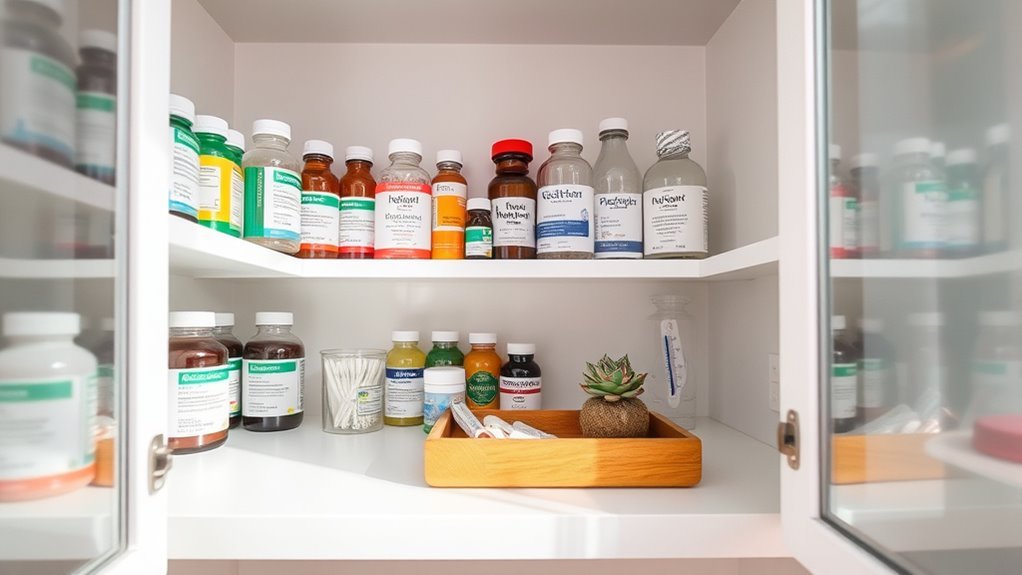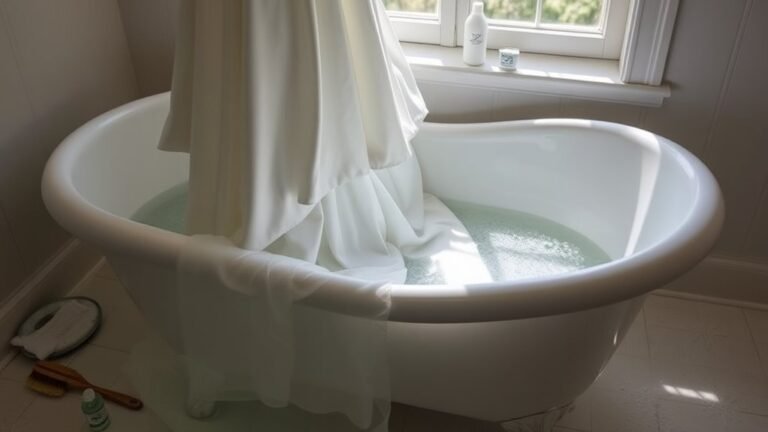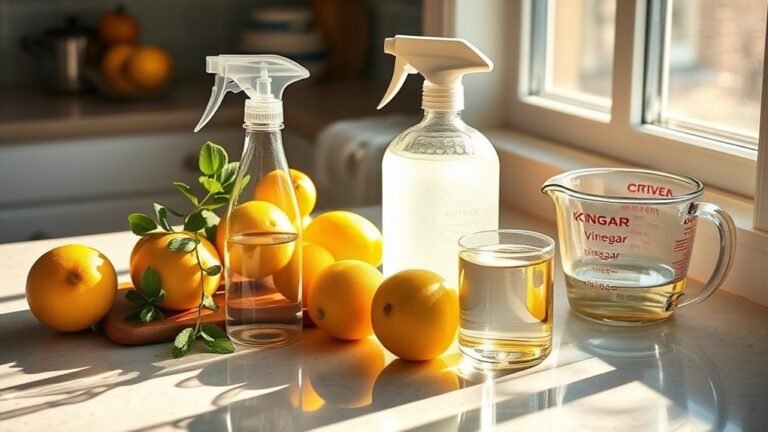How to Clean and Organize Your Medicine Cabinet
To clean and organize your medicine cabinet, start by gathering gloves, disinfectant wipes, and a trash bag. Remove expired or unused medications and learn proper disposal methods. Empty the cabinet and wipe it down with a mild cleaner, then let it air dry. Sort your essentials into categories like pain relief and first aid for easy access. Use clear containers and labels to keep things tidy and accessible. Keep going to discover tips that make this process even smoother.
Gather Supplies and Prepare Your Space
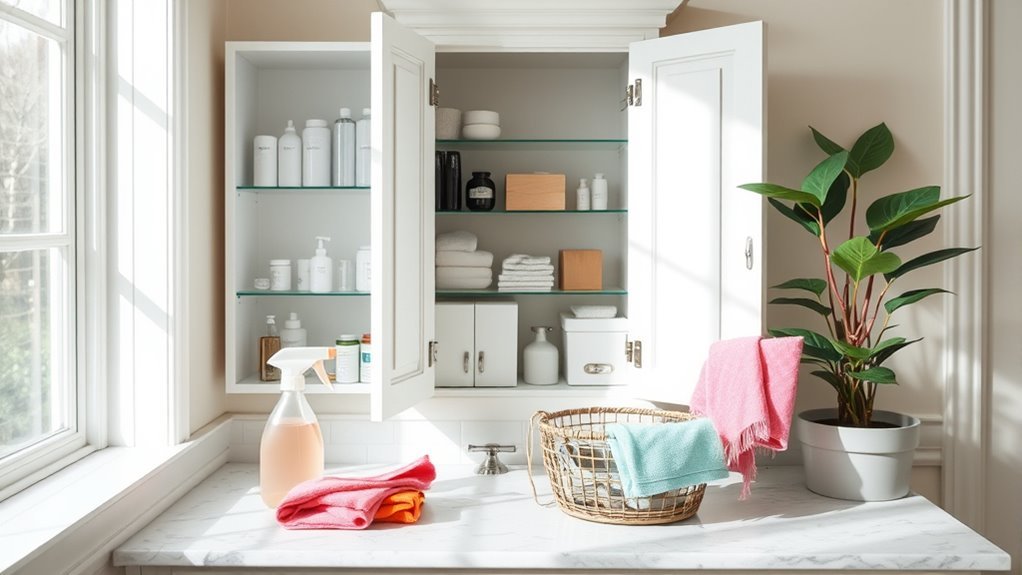
Before you plunge into cleaning, make certain you have all the necessary supplies on hand. Freedom starts with control, and having the right essential tools empowers you to tackle your medicine cabinet efficiently. Gather gloves, disinfectant wipes, a small trash bag, and a microfiber cloth. Safety precautions are key—wear gloves to protect your skin from germs and chemicals. Clear a workspace nearby to sort items comfortably without rushing. You’ll also want a sturdy box or basket to hold items you plan to keep temporarily. By preparing your space thoughtfully, you set the stage for a smooth, stress-free process. Taking these steps guarantees you maintain control over your environment, freeing you from clutter and chaos. Ready your supplies, and you’re one step closer to a well-organized cabinet.
Sort Through Medications and Discard Expired Items
Sorting through your medications is an essential step to guarantee your cabinet is both safe and organized. Start by checking expiration dates and separating outdated or unused items. Keeping expired medications not only clutters your space but also risks your health, so prioritize medication safety by removing anything past its prime. Next, review labels to identify any duplicates or prescriptions no longer needed. Once sorted, explore proper disposal methods—never toss meds in the trash or flush them unless the label says it’s safe. Many communities offer take-back programs or designated drop-off points, ensuring your old medications won’t harm the environment or others. By thoughtfully sorting and discarding, you reclaim control over your health space and maintain freedom from unnecessary risks.
Clean the Cabinet Thoroughly
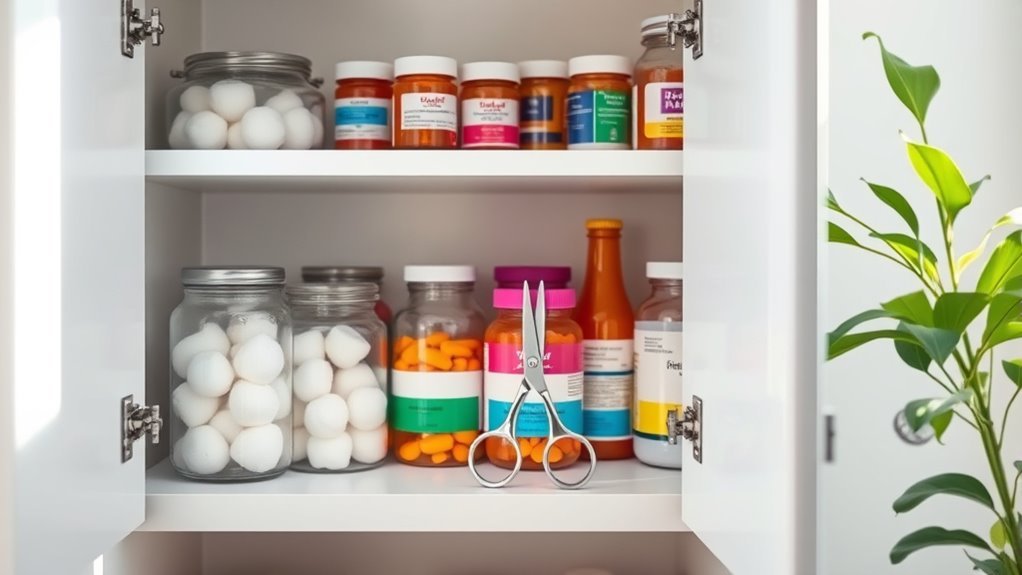
Once you’ve cleared out expired and unnecessary medications, it’s time to give your cabinet a proper cleaning. This step is essential for maintaining a fresh, hygienic space that supports your cabinet organization goals. Use these cleaning techniques to refresh your medicine cabinet:
- Remove all items and wipe down every surface with a mild disinfectant or a mixture of water and vinegar. This removes dust, spills, and germs.
- Pay extra attention to corners and shelves where residue tends to accumulate.
- Let the cabinet air dry completely before replacing items to prevent moisture buildup and mold growth.
Taking these steps frees you from clutter and grime, making your medicine cabinet a clean, organized haven that’s easy to manage.
Categorize and Group Your Essentials
Although organizing your medicine cabinet might seem overwhelming at first, categorizing and grouping your essentials will make it much easier to find what you need quickly. Start by identifying essential categories like pain relievers, cold and allergy remedies, first aid supplies, and vitamins. Once you’ve sorted everything, use grouping strategies that suit your habits—whether that’s by frequency of use, type, or even family member. This approach frees you from digging through clutter and saves time, helping you maintain control over your health essentials. By clearly defining these categories and sticking to simple grouping strategies, you’ll enjoy the freedom of easy access and peace of mind, knowing exactly where everything is when you need it most.
Implement Storage Solutions for Easy Access
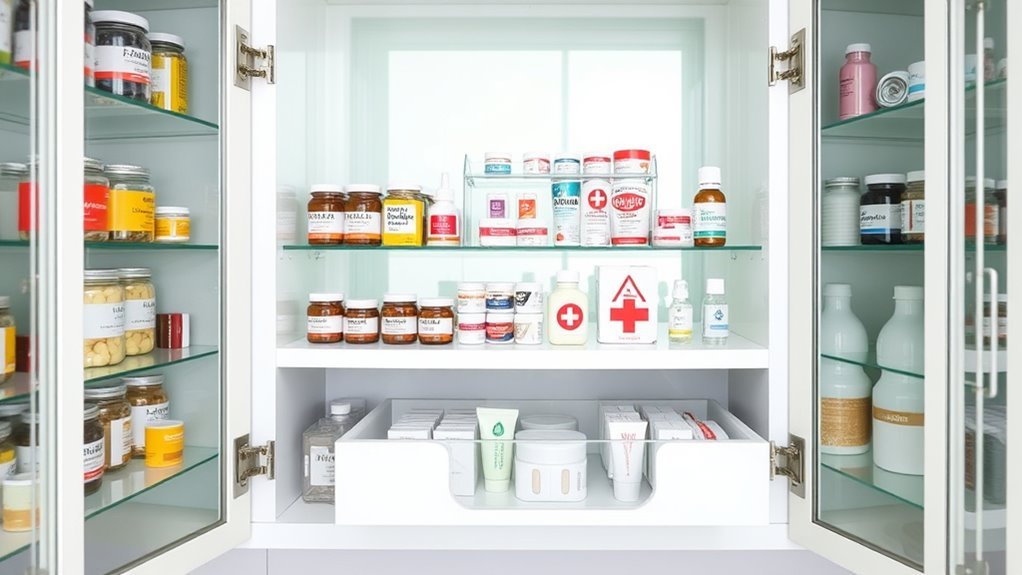
To make your medicine cabinet truly functional, you’ll want to implement smart storage solutions that keep everything within easy reach. Using clear containers is a game-changer—they let you see contents instantly, saving you time and hassle. Pair these with an effective label system to identify items quickly and maintain order effortlessly.
Here’s how to do it:
- Use clear containers to separate medications, first-aid supplies, and vitamins, so you can grab what you need without digging.
- Create a simple label system with easy-to-read fonts or color codes, making identification quick and intuitive.
- Store frequently used items at eye level for immediate access, while less critical supplies can go higher or lower.
This setup frees you from frustration and keeps your essentials organized and accessible.
Frequently Asked Questions
How Often Should I Clean My Medicine Cabinet?
You should aim to clean your medicine cabinet every three to six months to keep things fresh and manageable. Regular cleaning frequency helps prevent expired meds from piling up and keeps your space clutter-free. Use organizing tips like grouping similar items and using clear containers so you can grab what you need without hassle. Staying on top of this not only frees up space but also keeps you safe and stress-free.
Can I Store Medications in a Bathroom Cabinet Safely?
You probably shouldn’t store medications in a bathroom cabinet because bathroom humidity can cause them to degrade faster. Moisture and heat from showers can affect the medication’s effectiveness and lead to early expiration. Instead, keep your meds in a cool, dry place away from direct sunlight. This way, you’re free to rely on them when you need without worrying about reduced potency or safety issues.
What Should I Do With Unused Prescription Drugs?
Imagine your unused prescription drugs multiplying like wild rabbits—cluttering your space and risking your safety. To keep freedom intact, you’ve got to choose smart dispose methods. Don’t just toss meds in the trash or flush them; that’s a drug safety nightmare. Instead, use take-back programs or follow FDA guidelines for disposal. By doing this, you’re not only clearing space but protecting your home and environment, giving you peace of mind and freedom to live safely.
Are There Specific Temperatures to Store Medicines?
Yes, you should store medicines at ideal temperatures to maintain medication stability. Most meds do best at room temperature, between 68°F and 77°F (20°C to 25°C). Avoid places that get too hot, cold, or humid, like bathrooms or near windows. Keeping your meds stable means they’ll work properly when you need them, giving you the freedom to rely on them without worry. Always check specific storage instructions on the label.
How Do I Keep Medications Childproof?
Oh, because kids just love testing your patience by playing with your meds, right? To keep your freedom intact, invest in childproof locks for your medication storage—no more frantic chases or worries. Choose cabinets or boxes with secure latches that only you can open, and store meds out of their sight and reach. This way, you protect your little explorers while keeping your peace of mind and freedom to live worry-free.
